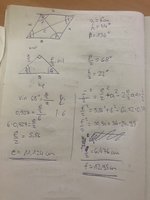You are using an out of date browser. It may not display this or other websites correctly.
You should upgrade or use an alternative browser.
You should upgrade or use an alternative browser.
Rhombus
- Thread starter minko
- Start date
HallsofIvy
Elite Member
- Joined
- Jan 27, 2012
- Messages
- 7,763
I would be inclined to use the "cosine law": if a triangle has side a, b, c and the angle between sides a and b is C, then \(\displaystyle c^2= a^2+ b^2- 2ab cos(C)\).
Here you are given that all four sides have length a= 6 cm and that one angle is \(\displaystyle \alpha= 44\) degrees. You have correctly determined that the other angle is \(\displaystyle \beta= 180- 44= 136\) degrees.
The longer diagonal, opposite the angles \(\displaystyle \beta\), we have \(\displaystyle d_1^2= 2(6^2)- 2(6^2)cos(136)\).
For the shorter diagonal, opposite the angles \(\displaystyle \alpha\), we have \(\displaystyle d_2^2= 2(6^2)- 2(6^2)cos(44)\).
Here you are given that all four sides have length a= 6 cm and that one angle is \(\displaystyle \alpha= 44\) degrees. You have correctly determined that the other angle is \(\displaystyle \beta= 180- 44= 136\) degrees.
The longer diagonal, opposite the angles \(\displaystyle \beta\), we have \(\displaystyle d_1^2= 2(6^2)- 2(6^2)cos(136)\).
For the shorter diagonal, opposite the angles \(\displaystyle \alpha\), we have \(\displaystyle d_2^2= 2(6^2)- 2(6^2)cos(44)\).
Can we use pythagoras theorem to get e and f sides ?I would be inclined to use the "cosine law": if a triangle has side a, b, c and the angle between sides a and b is C, then \(\displaystyle c^2= a^2+ b^2- 2ab cos(C)\).
Here you are given that all four sides have length a= 6 cm and that one angle is \(\displaystyle \alpha= 44\) degrees. You have correctly determined that the other angle is \(\displaystyle \beta= 180- 44= 136\) degrees.
The longer diagonal, opposite the angles \(\displaystyle \beta\), we have \(\displaystyle d_1^2= 2(6^2)- 2(6^2)cos(136)\).
For the shorter diagonal, opposite the angles \(\displaystyle \alpha\), we have \(\displaystyle d_2^2= 2(6^2)- 2(6^2)cos(44)\).
HallsofIvy
Elite Member
- Joined
- Jan 27, 2012
- Messages
- 7,763
I don't know what you mean by "e and f sides". Do you mean the two diagonals? I suppose you could but why? You would just end up re-deriving the cosine law.
Yes i meant diagonals, i thought that law of sines we can use only in triangle.I don't know what you mean by "e and f sides". Do you mean the two diagonals? I suppose you could but why? You would just end up re-deriving the cosine law.
Cubist
Senior Member
- Joined
- Oct 29, 2019
- Messages
- 1,686
On the RHS of your answer you seem to have used tried using the cosine law, but you have written "sin" instead of "cos".
For this reason your value of "f" is wrong.
The LHS of your answer obtains "e" very quickly. Why not use a similar method to obtain "f"?
For this reason your value of "f" is wrong.
The LHS of your answer obtains "e" very quickly. Why not use a similar method to obtain "f"?
So for the diagonal e is right answer ?On the RHS of your answer you seem to have used tried using the cosine law, but you have written "sin" instead of "cos".
For this reason your value of "f" is wrong.
The LHS of your answer obtains "e" very quickly. Why not use a similar method to obtain "f"?
Cubist
Senior Member
- Joined
- Oct 29, 2019
- Messages
- 1,686
So for the diagonal e is right answer ?
Yes, approximately. sin(68°)*6*2 ≈ 11.1262
An for the diagonal f i got answer 4.5 cm and f/2 is 2.256cm, i think thats correctYes, approximately. sin(68°)*6*2 ≈ 11.1262
Cubist
Senior Member
- Joined
- Oct 29, 2019
- Messages
- 1,686
An for the diagonal f i got answer 4.5 cm and f/2 is 2.256cm, i think thats correct
That's approximately correct. Another way of working it out would have been
f = cos(68°)*6*2 ≈ 4.4953cm
OR Pythagoras
[math] \left(\frac{f}{2}\right)^2 = 6^2- \left(\frac{e}{2}\right)^2 [/math]
Thank you very much for your helpThat's approximately correct. Another way of working it out would have been
f = cos(68°)*6*2 ≈ 4.4953cm
OR pythagoras
[math] \left(\frac{f}{2}\right)^2 = 6^2- \left(\frac{e}{2}\right)^2 [/math]

